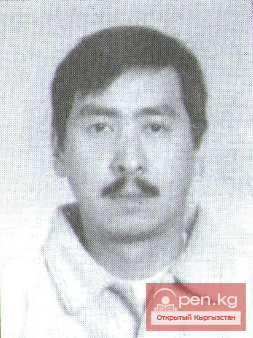Central Asian Sakas and Central Asia (according to paleoanthropology)
Regarding the origin of Saka monuments in the Tian Shan and Semirechye regions, which include not only Northern Kyrgyzstan but also the southeastern areas of Kazakhstan, there are currently two opposing viewpoints. According to one of them, the most widespread, the Saka cultural community formed here based on a local variant of the Andronovo culture of the Bronze Age. However, the actual continuity of such a transition is not traced in the archaeological materials. Finds characterizing the early Saka period are relatively few and often of random origin; according to another hypothesis, the culture of the Sakas of Tian Shan and Semirechye is not a logical development of the traditions of the local Andronovo people.
The early Scythian cultural complex forms by the beginning of the 1st millennium BC in the Central Asian region - in the territory of Western Mongolia, Tuva, and neighboring areas, and then, as a result of large-scale migration, spreads far to the west. In support of this hypothesis, in addition to archaeological facts, data from folklore, information from ancient authors, and others are provided.
Paleoanthropological materials play an important role in resolving the question of the origin of the culture of the Central Asian Sakas. Excavations by A.N. Bernstein in 1945-49 in Central Tian Shan provided 12 (6 male, 6 female) skulls of Sakas from the 7th-3rd centuries BC for study. Based on these materials, V.V. Ginzburg determined that the skulls of the Sakas of Tian Shan belong to brachycranial Europoids. Among them, the Andronovo type and transitional forms to the race of the Central Asian interfluve are not uncommon. Mongoloid admixture is only revealed in the slightly protruding nose and flattened face of women. According to V.V. Ginzburg, the brachycranial Europoid type of Tian Shan Sakas arises as a result of epochal changes - the gracilization of the Andronovo type.
A comparison of the Sakas of Tian Shan and Semirechye showed that they are quite close morphologically, but in the territory of Kazakhstan, one can see a significant admixture of Mongoloid race types during the Saka period. According to V.V. Ginzburg and T.A. Trofimova, there was a process of mixing the more ancient local population of the Bronze Age with nomads coming from the east. This mixing had only just begun and was more mechanical than genetic in nature. In the territory of Kyrgyzstan, however, there is no direct evidence of mixing with groups of Mongoloid type.
It is possible that the newcomers from the east played a lesser role in the ethnogenesis of the population of the Saka culture here.
Subsequently, this conclusion was questioned by T.K. Khojaev, who used quantitative indicators - ULO, PFC, UDM indexes to assess the expression of Mongoloid admixture. According to his calculations, the flattening of the facial skeleton (UFS) in the Sakas of Tian Shan is equal to 37.0, while the proportion of the Mongoloid element (UDOLE) is 26.5, whereas for the Sakas of Kazakhstan UFS=27.5 and UDMZ=20.9.
New paleoanthropological materials obtained from archaeological research of Saka monuments in Tian Shan in recent years (excavations by K.I. Tashbaeva, A.K. Abetekov, K.Sh. Tabaldiev) allow for significant clarification of the anthropological composition of Central Asian Sakas and substantial corrections to the understanding of their ethnogenesis. Currently, the craniological series characterizing the Saka population of Tian Shan includes 28 male and 18 female skulls.
Male skulls are generally brachycranial, of medium length and height, and wide. The height-length index is average, and the height-breadth index is small. The forehead is wide, especially in the coronal part, convex, and slightly sloping.
The face is wide, absolutely and relatively medium-high. The facial-cranial indicators are average. The horizontal profiling of the face is weakened, especially at the upper level - the value of the nasomalar angle is close to larger values. The overall angle of facial projection in the vertical plane is large; however, the alveolar part is mesognathous, and the Flauar index is average. The orbits are wide, medium-high, and chamaconch. The nose is of medium size, mesorrhine. The nasion in absolute measurement is high, the symbiotic indicator is large, and the dacryal is average. The angle of nasal projection is large.
Deviations of empirical dispersions, coefficients of variation, and correlation coefficients from the standards indicate the heterogeneity of the male skulls of the Tian Shan Sakas. To establish the relationship in the regional series of intergroup and intragroup variability, the material was divided by burial mounds. From Kurankey, there are 6 skulls, from Alamyshik - 4, from Dzhiel-Aryk - 3, from Keden - 2. The other burial mounds are represented by single skulls and were combined into one collective group. A comparison of skulls from different burial mounds shows their significant divergence in a number of traits.
The Alamyshik skulls are characterized by brachycephaly, a wide, medium-high, mesoprosopic, moderately flattened, orthognathous face with mesoconch orbits and a strongly protruding nose. The same Europoid brachycranial type with a wide, medium-high face is also noted in the skulls from the collective series. They differ from the Alamyshik skulls only in slightly less elongated proportions of the face and orbits.
The burial mounds of Kurankey, Dzhiel-Aryk, and Keden are concentrated with mixed Mongoloid-Europoid forms.
The skulls from Kurankey are distinguished by mesobrachycephaly, a high, wide, mesoprosopic, flat in the nasomalar area, and moderately flattened in the zygomatic-maxillary area face, and a medium-protruding nose. The skulls from Dzhiel-Aryk and Keden are characterized by hyperbrachycephaly, a medium-high, very wide, low by index, and flat face, chamaconch orbits, and a medium-protruding nose. Their distinctive feature is a large Flauar index and a tendency towards alveolar prognathism. Fragments from several more skulls, unsuitable for measurements due to poor preservation, were found in Dzhiel-Aryk and the "royal" mounds of Keden. All of them demonstrate various traits noted on whole skulls, confirming the reliability of the identified morphological complex.
Significant differences along the line of Europoid-Mongoloid between the skulls of Alamyshik and the collective series, on the one hand, and the skulls of Kurankey, Dzhiel-Aryk, and Keden, on the other hand, are clearly reflected in the ULS, PFC, UDM indexes. It is generally accepted that ULS values less than or equal to 20.0 and PFC values less than or equal to 90.6 indicate the absence of Mongoloid admixture, while ULS values exceeding 80.0 and PFC values exceeding 96.8 are characteristic of "pure" Mongoloids.
Kurankey: 6 ULO=56.5 PFC=94.9 UDM=3.8
Dzhiel-Aryk, Keden: ULS=54.9 PFC=95.3 UDM=75.1
Alamyshik: ULO=29.6 PFC=90.8 UDM=12.0
Collective series: ULS=6.90 PFC=94.0 UDM=13.0
Thus, the burial mounds of Kurankey, Dzhiel-Aryk, and Keden are concentrated with Mongoloid types characterized by significant Mongoloidness. However, the nature of the Mongoloid component represented in these groups is not uniform. The Mongoloid component that entered the mixed type from Kurankey is characterized by a high and wide face with mesoconch orbits. The Mongoloid component represented in the burial mounds of Dzhiel-Aryk and Keden is distinguished by a wide but low face, relatively low orbits, and alveolar prognathism.
Excavations in the territory of Inner Tian Shan









































